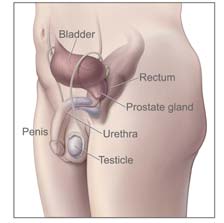|
Introduction to the Prostate
What is the prostate?
How does the prostate change as you get older?
What prostate changes should you be aware of?
What are common tests for prostate changes?
You may be reading this booklet because you are having prostate
problems. The booklet can help answer your questions about
prostate changes that happen with age, such as:
- What are common prostate changes?
- How are these changes treated?
- What do I need to know about testing for prostate
changes, including cancer?
This booklet can give you basic information about common
prostate changes. If you are making decisions about prostate
cancer treatment, there are other resources available. See the For
More Information section.
The
prostate
is a small gland in men. It is part of the male
reproductive system.

The prostate is about
the size and shape of
a walnut. It sits low
in the
pelvis, below
the
bladder
and
just in front of the
rectum. The
prostate helps make
semen, the milky
fluid that carries
sperm
from the
testicles
through
the
penis
when a
man
ejaculates.
The prostate surrounds part of the
urethra, a tube that carries
urine
out of the bladder and through the penis.
The prostate gland surrounds the tube (urethra) that passes urine.
This can be a source of problems as a man ages because:
- The prostate tends to grow bigger with age and may
squeeze the urethra (see drawing) or
- A
tumor
can make the prostate bigger
These changes, or an infection, can cause problems passing urine.
Sometimes men in their 30s and 40s may begin to have these
urinary
symptoms and need medical attention. For others,
symptoms aren't noticed until much later in life. Be sure to tell
your doctor if you have any urinary symptoms.
|
Tell your doctor if you:
|
- Are passing urine more during the day
- Have an urgent need to pass urine
- Have less urine flow
- Feel burning when you pass urine
- Need to get up many times during the night to
pass urine
|
Growing older raises your risk of prostate problems. The three
most common prostate problems are:
One change does not lead to another. For example, having
prostatitis or an enlarged prostate does not raise your chance of
prostate cancer. It is also possible for you to have more than one
condition at the same time.
|
Most men have prostate changes that are not
cancer. |
Abnormal findings from any of these tests can help diagnose a
problem and suggest the next steps to take:
- DRE (digital rectal exam)--a test to feel the prostate
- PSA (prostate-specific antigen) test--a blood test
- Biopsy--a test to check for cancer
See the Types of Tests section.
Back to Top
Next Section > |